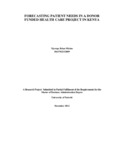| dc.description.abstract | Forecasts are crucial for practically all economic and business decisions. The focus of this
research paper is in the area of forecasting. The purpose of a forecast is to reduce the range of
uncertainty within which management judgements must be made. The research approach
adopted is a case study of the Nutrition and HIV Program (NHP), which is a donor funded
public health project. The general objective of this study was to forecast the demand for patient
needs in a donor funded project. Specifically, this study sought to explain the current method
used, determine the factors that influence the selection of forecasting strategy, review and
evaluate the accuracy of the current method and establish a more suitable forecasting method
that can accurately predict demand for nutrition commodities. The findings from this research
provide evidence that forecasts did influence decision making in the key functional areas of the
project. Also, that strategy, government and donor policies were the main factors that affected
the selection of a forecasting strategy. Further, the review and evaluation of the current
forecasting method indicated that there was a significant difference between the actual and
forecasted consumption. In order to establish a more suitable forecasting method, Univariate
Box – Jenkins (UBJ) methodology was used and two models were tested and Auto Regressive
Integrated Moving Average (ARIMA (0, 1, 2)) model provided a better fit and was chosen as
the model of choice for a short run forecast horizon. The main conclusion drawn from this
study is that, UBJ-ARIMA models are useful as benchmarks for forecasting and therefore they
should be viewed as complements to a reliable forecasting process. This study recommends
that public health projects need to consider adopting business forecasting methods that will
provide a better glimpse of the future based on historical events rather than relying on disease
morbidity data trends | en |

